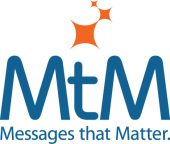There is often a debate about what positioning is, and what it is not. Confusing matters further, there are two proper usages of “positioning:”
1. How your company is situated relative to its competitors;
2. How your products and services are situated in the minds of customers and target audiences.
This discussion focuses exclusively on No. 2. At Messages that Matter, we define positioning as a mental space in your target audience’s mind that you can own with an idea that has compelling meaning to the recipient. It’s in this mental space where your product, solution, service or company’s most important benefit and the customer’s most important need meet, and hopefully form a meaningful relationship.
Positioning is like story telling. Done well it can engross you. Done poorly and you stop reading. It is the most important aspect of B2B technology marketing because it is the foundation for everything you do in marketing. Effectively done, positioning quickly tells the recipient of your marketing message why they should care about your product, solution, technology or company.
In Crossing the Chasm, Geoffrey Moore writes, “Positioning is the single largest influence on the buying decision.” Moore describes a position as a buyer’s shorthand for the best solution for a particular problem.
Effective positioning makes prospects want to know more
Good positioning entices a potential prospect to learn more about your offering. It also serves as the first level of qualification. Ideally you want a recipient to react to your message by thinking either “that’s me,” or “that’s not me.”
In order to get that reaction, and to gain access to that mental space in your target market’s mind, you need to know your customer and competition as well as you know your offering or company. Study and evaluate your competitors’ positioning strategies and then map them out. Interview lots of customers so you really understand them. You need to know what will get your prospects’ attention, and what’s keeping them awake at night.
Your target audience will listen when you speak their language by emphasizing that you can solve their pressing business problem. But they won’t listen if you sound just like everyone else in your market.
Pay attention to how your competitors are positioned
Differentiation is essential because your target audience is good at ignoring marketing messages, especially those that they have heard before from your competitors. They’ll also ignore positions that are overused and common in many B2B markets today such as “transformation,” innovation” and “inspiration.”
In the marketing classic, “Positioning: The Battle for your Mind,” Ries and Trout lament that “… too many companies embark on marketing and advertising as if the competitor’s position did not exist. They advertise their products in a vacuum and are disappointed when their messages fail to get through.”
Most B2B technology companies complain about long sales cycles. But failure to differentiate is the main reason prospects take so long to decide. They are confused. They can’t tell one option from others; everyone is saying the same thing.
Good positioning never gets old or stale
To claim a position requires patience and conviction while others in your company may want to try something new. Good positioning never gets old or stale. That’s because your positioning statement should be a conceptual idea and not necessarily copy. A good idea can be expressed in many different ways.
Your positioning statement becomes the central theme for all marketing from your web site to collateral materials to press releases. But no matter how clever or compelling your positioning statement is, it won’t stick unless is executed consistently, and repeatedly over a long period of time; like several years! Remember, the longer you stick with your positioning strategy, the more likely you will be to claim that mental space in your target audience’s mind.
If your positioning statement meets the following criteria, you’re on your way to establishing a position in your target audience’s mind:
1. Your positioning statement needs to be unique. No competitor is making a similar claim.
2. It needs to be believable and important; it addresses the target buyer’s No. 1 problem.
3. It needs to be adaptable to others involved in the buying process in case you need to message to different audiences.
4. It needs to be useable in all types of marketing communications and sales presentations; you can create sample marketing materials (press release, e-mail blast, web site content, etc.) to test for usability.
